Introduction: ChatGPT for Teachers
Welcome to the world of “ChatGPT for Teachers,” where AI meets K–12 education. In this post, we’re diving into a special framework called ACHIEVE. It’s all about making the most of ChatGPT for things like looking at student data, saving time, and getting creative in the classroom.
ACHIEVE stands for:
Aid in Human Coordination,
Cut Out Tedious Tasks,
Help Provide a Safety Net,
Inspire Better Problem Solving and Creativity,
and Enable Great Ideas to Scale Faster.
We’ll show you how ChatGPT can help teachers like you in many ways. From making sense of grades and test scores to planning cool lessons and working together better with other teachers, ChatGPT is here to lend a hand.
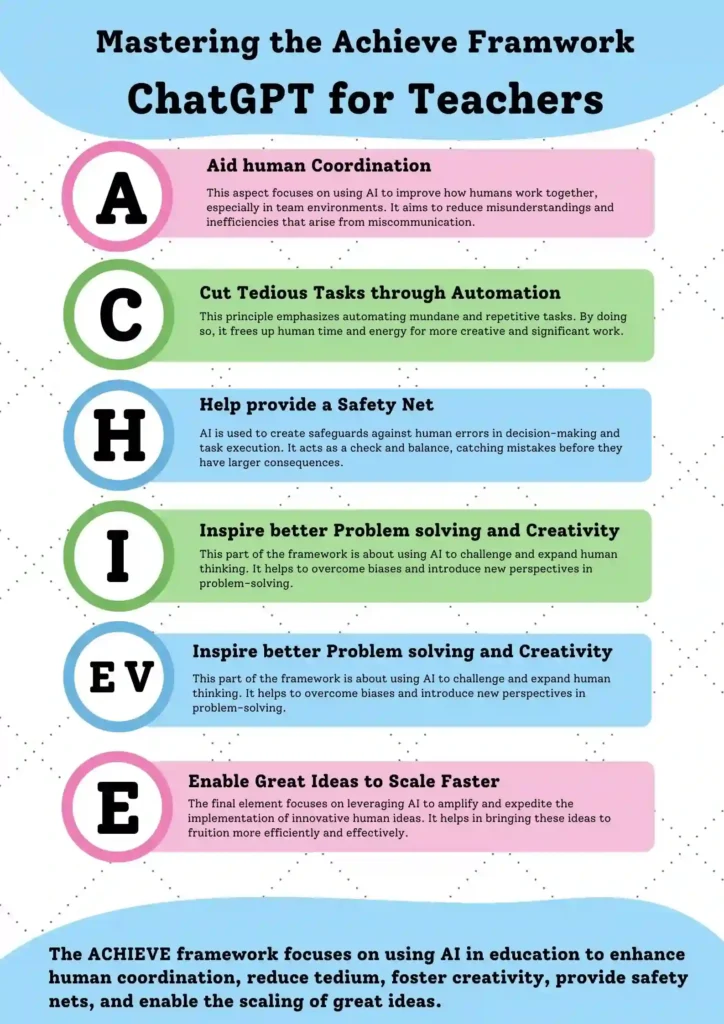
Whether you’re already good with tech or just starting out, you’ll find helpful tips on using ChatGPT to make teaching and learning even better. Let’s get started and see what ChatGPT can do for you!
Aid in Human Coordination with a Data Analysis Focus
ChatGPT can greatly assist K–12 teachers in organizing and analyzing classroom data for better coordination. Here are specific use cases and ChatGPT prompts that incorporate data analysis:
Analyzing Parent-Teacher Meeting Feedback:
- Use Case: Evaluating feedback from parents post-meetings.
- ChatGPT Prompt: “Analyze the responses from the parent-teacher meeting feedback forms for my 5th-grade class. Highlight key areas of praise and concern.”
- Example: Teachers can input data from feedback forms, and ChatGPT can provide a summary of the main points, helping to understand parent concerns and appreciations.
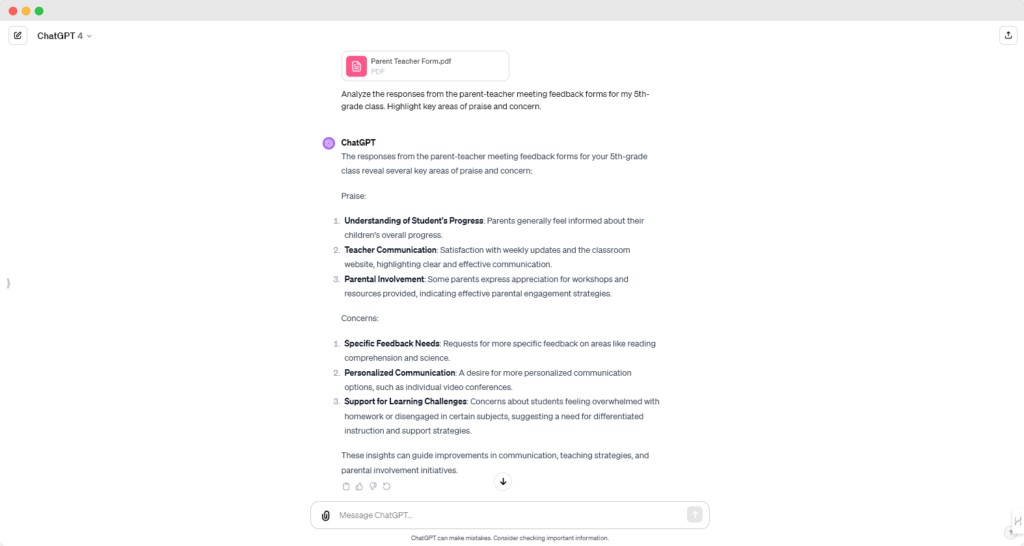
Group Project Performance Analysis:
- Use Case: Reviewing the effectiveness of group roles in projects.
- ChatGPT Prompt: “Based on the provided data on student participation and project grades, analyze the effectiveness of assigned roles in the 6th-grade renewable energy group project.”
- Example: Teachers can input data regarding student participation and project outcomes, allowing ChatGPT to identify which roles and strategies were most successful.
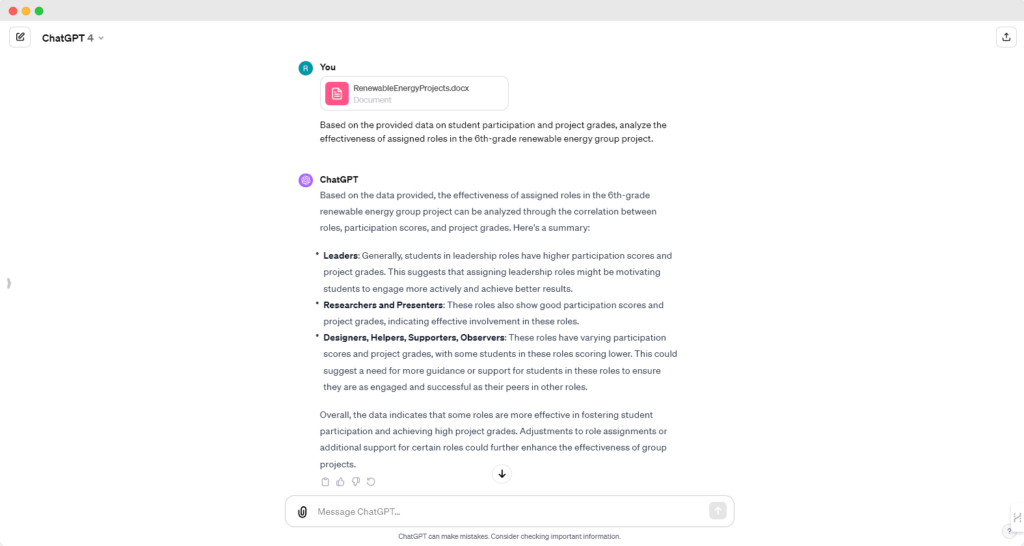
Streamlining Communication with Data-Driven Updates:
- Use Case: Creating data-driven communications for parents.
- ChatGPT Prompt: “Generate a summary of the 3rd-grade class performance in math this semester, including areas of improvement and excellence, to include in the bi-weekly newsletter.”
- Example: ChatGPT can use class performance data to craft informative updates for parents, providing insights into their child’s educational progress.
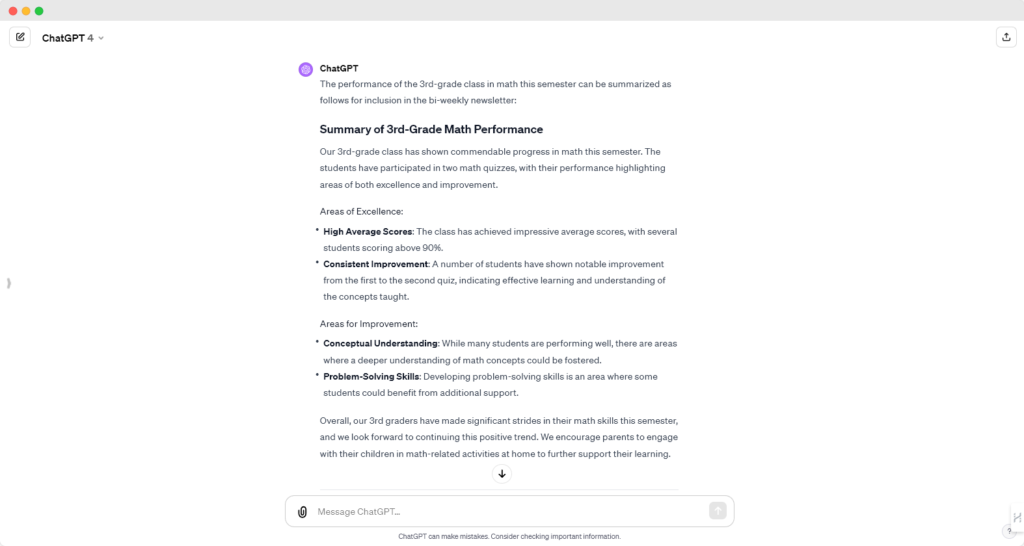
Resource Utilization Analysis:
- Use Case: Assessing the effectiveness of class resources.
- ChatGPT Prompt: “Evaluate the usage data of online resources provided for the 4th-grade history project on Ancient Egypt. Identify the most and least accessed materials.”
- Example: Teachers can feed usage data into ChatGPT, which can then analyze and identify the most beneficial resources for students.
Incorporating data analysis in these ways enables teachers to make informed decisions, tailor their teaching strategies, and improve student outcomes.
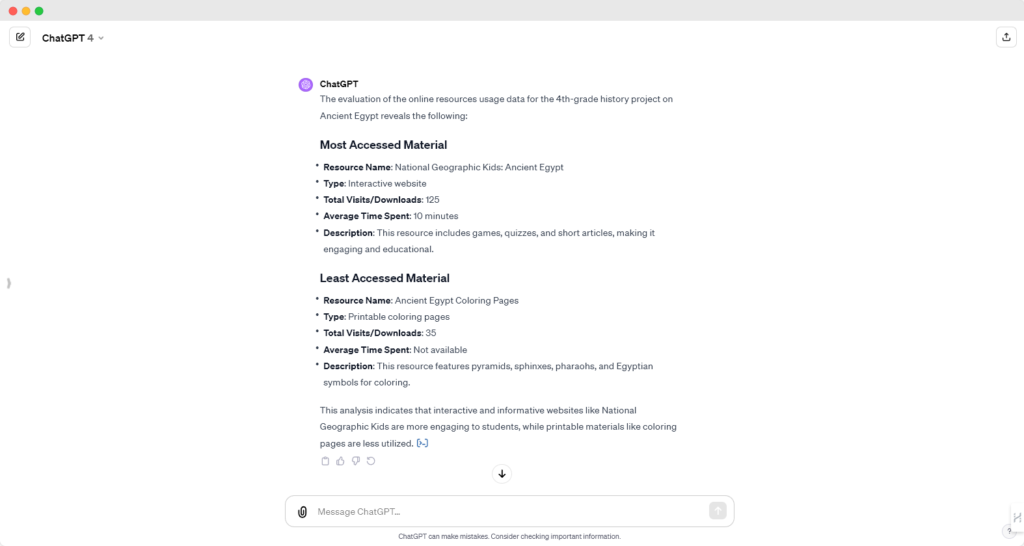
Cut Out Tedious Tasks Through Data Analysis
ChatGPT can significantly reduce the time K–12 teachers spend on repetitive data-related tasks. Here are specific examples and prompts where ChatGPT aids in handling data efficiently:
Grading and Assessment Analysis:
- Use Case: Quickly grading tests and analyzing student performance.
- ChatGPT Prompt: “Analyze the grade data from the recent 7th-grade math test and identify trends in student performance, especially in algebraic questions.”
- Example: Teachers can input test scores, and ChatGPT can provide an analysis, highlighting areas where students excel or struggle.
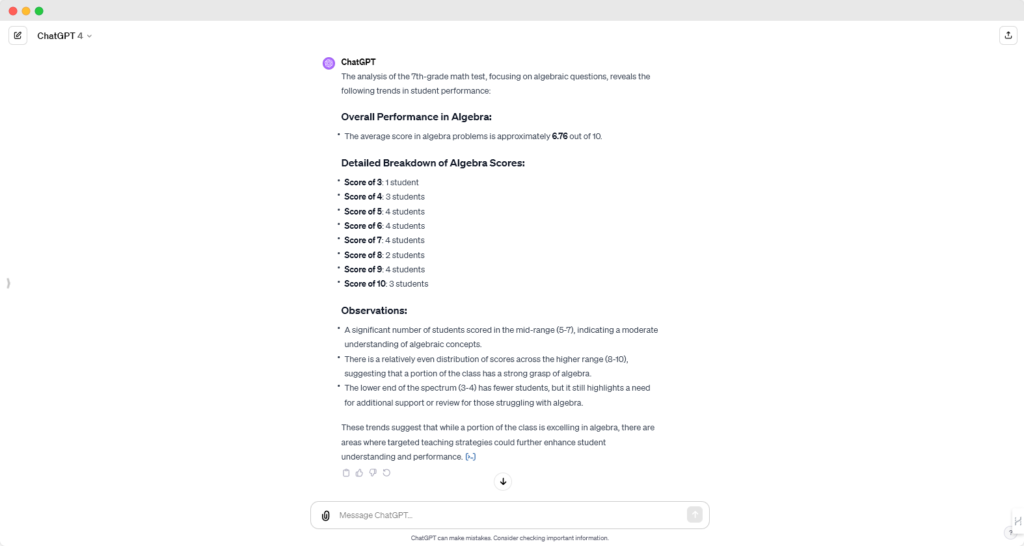
Attendance and Participation Tracking:
- Use Case: Monitoring student attendance and classroom participation.
- ChatGPT Prompt: “Review the attendance and participation data for my 8th-grade English class over the past month and summarize any notable patterns.”
- Example: By entering attendance records, ChatGPT can detect trends, like frequent absences or changes in participation levels.
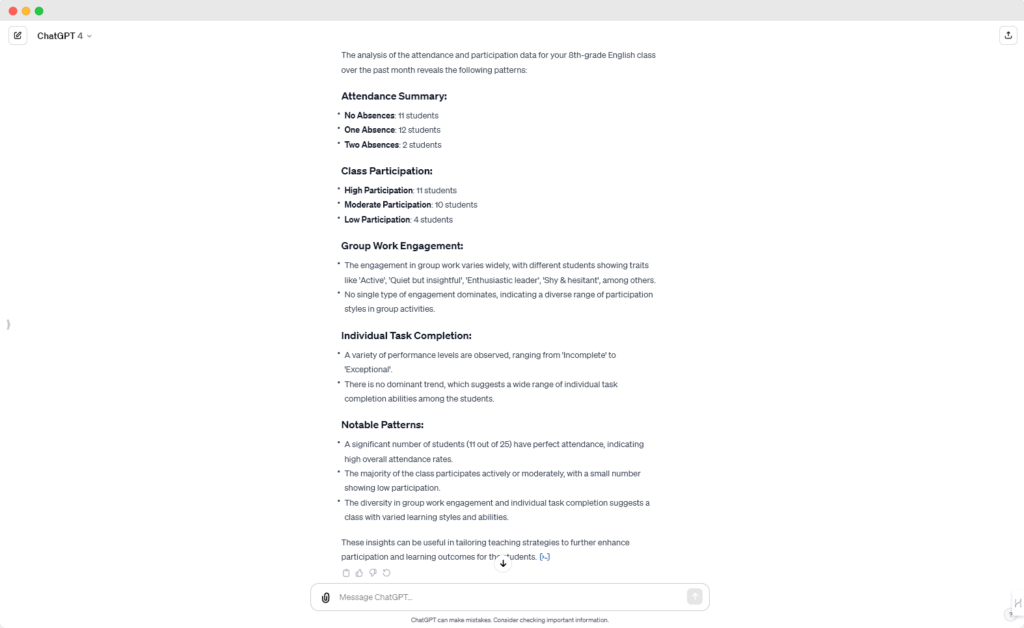
Survey Data Interpretation:
- Use Case: Interpreting feedback from student surveys.
- ChatGPT Prompt: “Interpret the results of the student interest survey for the 6th-grade science curriculum and suggest areas for enrichment.”
- Example: ChatGPT can analyze survey responses, helping teachers understand student interests and adapt their teaching accordingly.
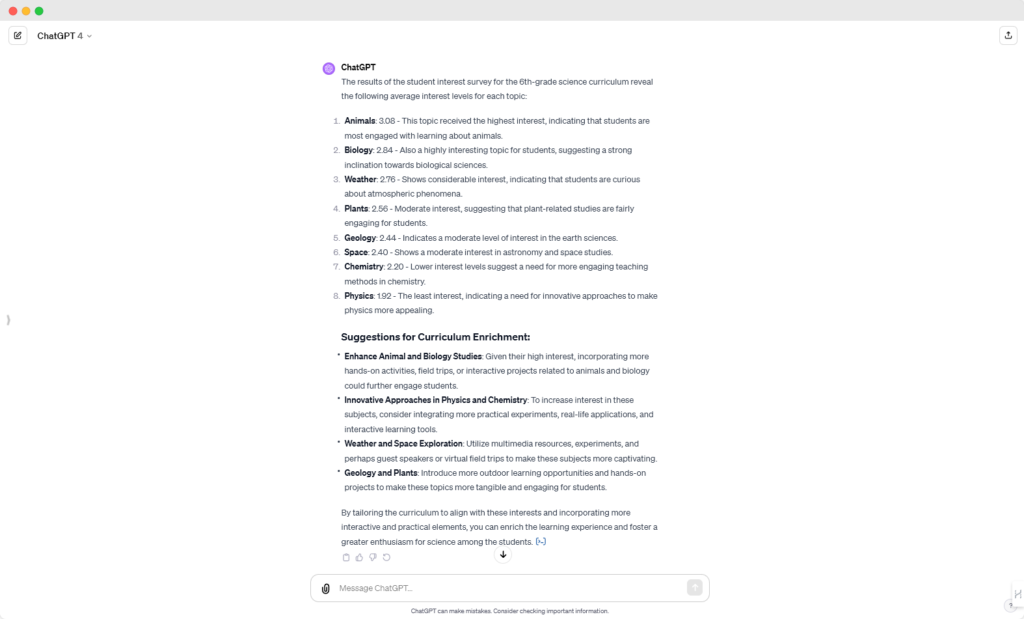
Resource Allocation Efficiency:
- Use Case: Optimizing the use of classroom resources based on data.
- ChatGPT Prompt: “Analyze the usage data of different classroom stations in my 4th-grade class to determine which are most and least popular.”
- Example: ChatGPT can assess resource usage data, allowing teachers to make informed decisions on resource allocation and station setups.
By leveraging ChatGPT for these data analysis tasks, teachers can save time and focus more on the interactive and creative aspects of teaching.
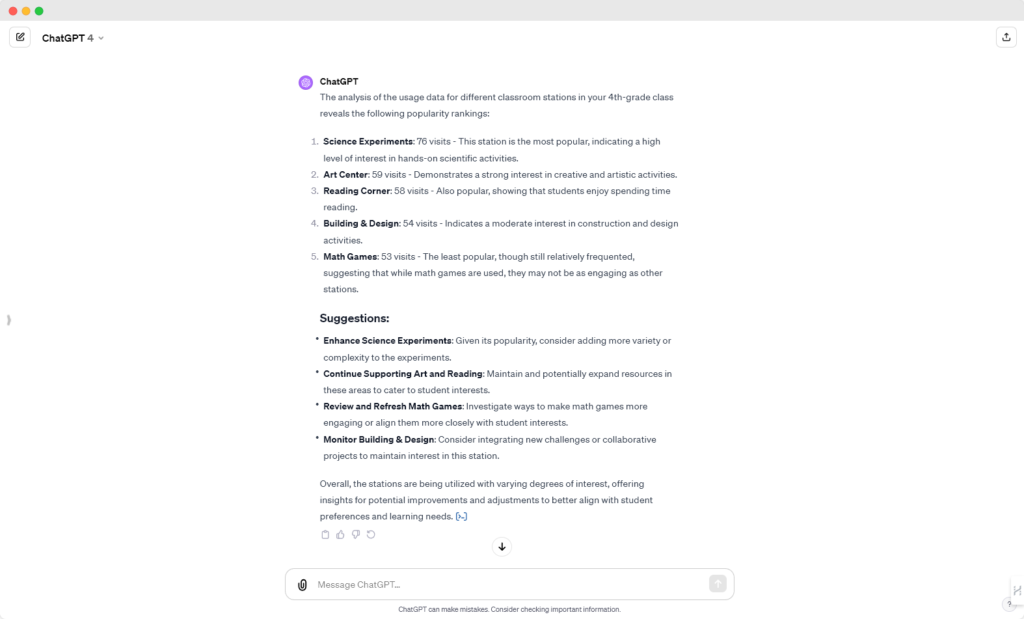
Help Provide a Safety Net
In the context of K–12 education, ChatGPT can act as a valuable safety net for teachers, especially when it comes to data analysis and ensuring accuracy in various educational processes. Here are some specific examples and ChatGPT prompts that teachers can use:
Expense Report Compliance for School Events:
- Use Case: Verifying if expenses for school events comply with school policies.
- ChatGPT Prompt: “Review the attached expense report for the 6th-grade field trip and check for compliance with the school’s financial policies. Highlight any discrepancies.”
- Example: Teachers can upload expense details, and ChatGPT can cross-reference them with school policies, ensuring compliance and avoiding financial errors.
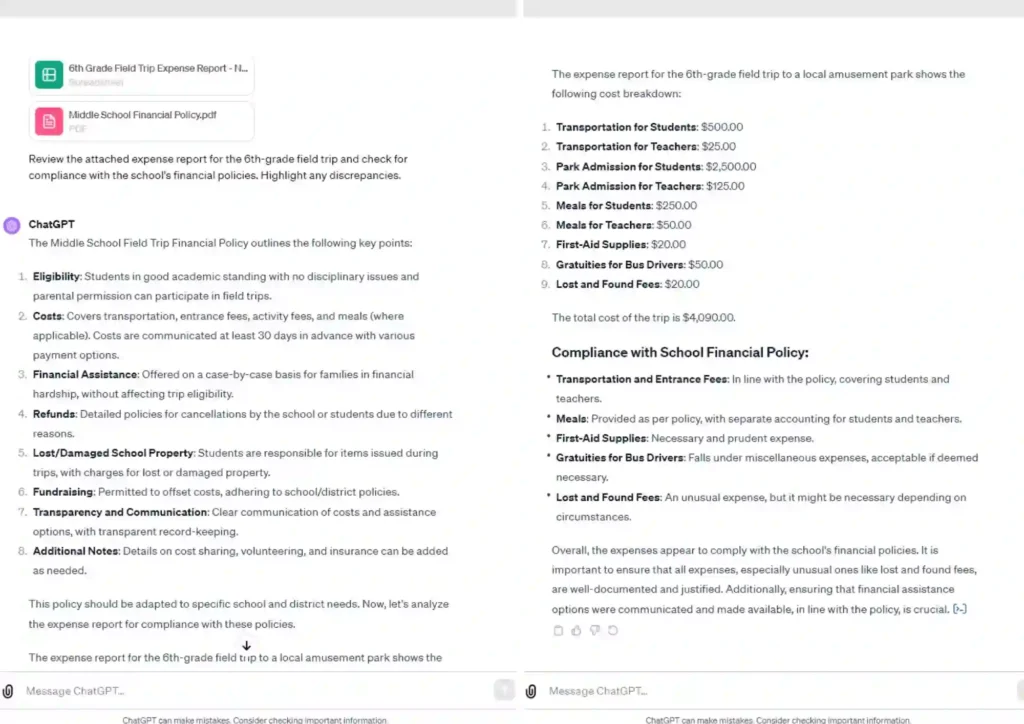
Analyzing Educational Grant Proposals:
- Use Case: Ensuring grant proposals meet all criteria.
- ChatGPT Prompt: “Review the grant proposal for the new science lab, specifically comparing its objectives, budget, sustainability plan, and community involvement aspects against the district’s grant criteria. Provide detailed suggestions for improving these areas of the proposal to better align with the guidelines.”
- Example: ChatGPT can analyze the proposal against the grant criteria, helping teachers strengthen their proposals and increase their chances of approval.
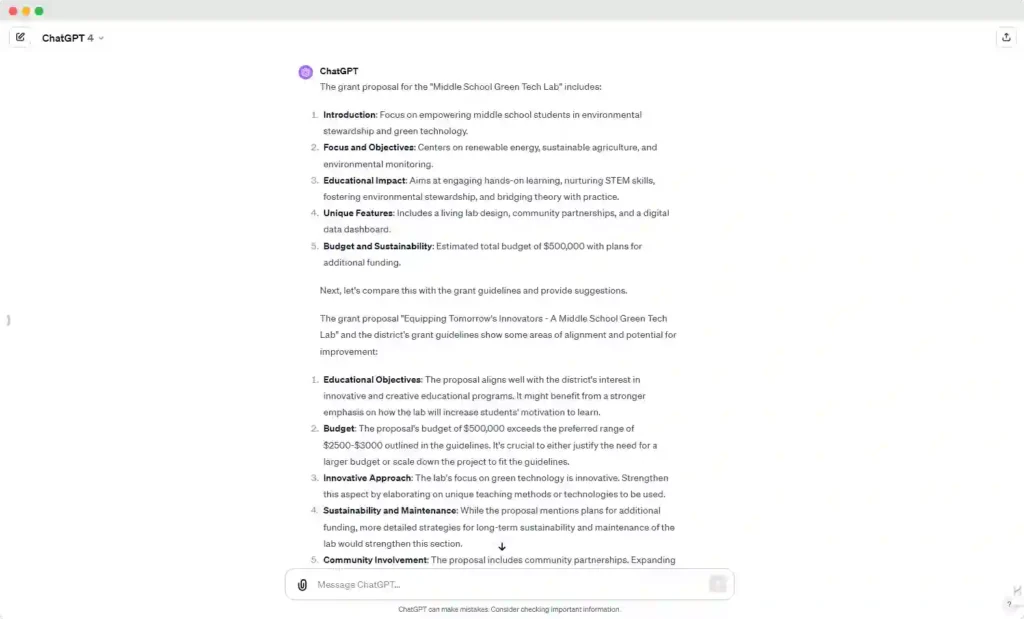
Checking for Errors in Student Reports:
- Use Case: Error-checking student progress reports before sending them to parents.
- ChatGPT Prompt: “Cross-check the final grades and comments in these student reports with the grade book entries for accuracy.”
- Example: Teachers can use ChatGPT to ensure that the grades and comments in reports accurately reflect the grade book records, preventing miscommunication with parents.
Ensuring Alignment with Educational Standards:
- Use Case: Aligning lesson plans and assessments with educational standards.
- ChatGPT Prompt: “Review my lesson plan for 8th-grade social studies and check its alignment with the state educational standards for this grade level.”
- Example: ChatGPT can compare lesson plans to state standards, ensuring that the content and objectives are properly aligned.
These examples demonstrate how ChatGPT can provide a reliable safety net, helping teachers avoid errors in various educational and administrative tasks.
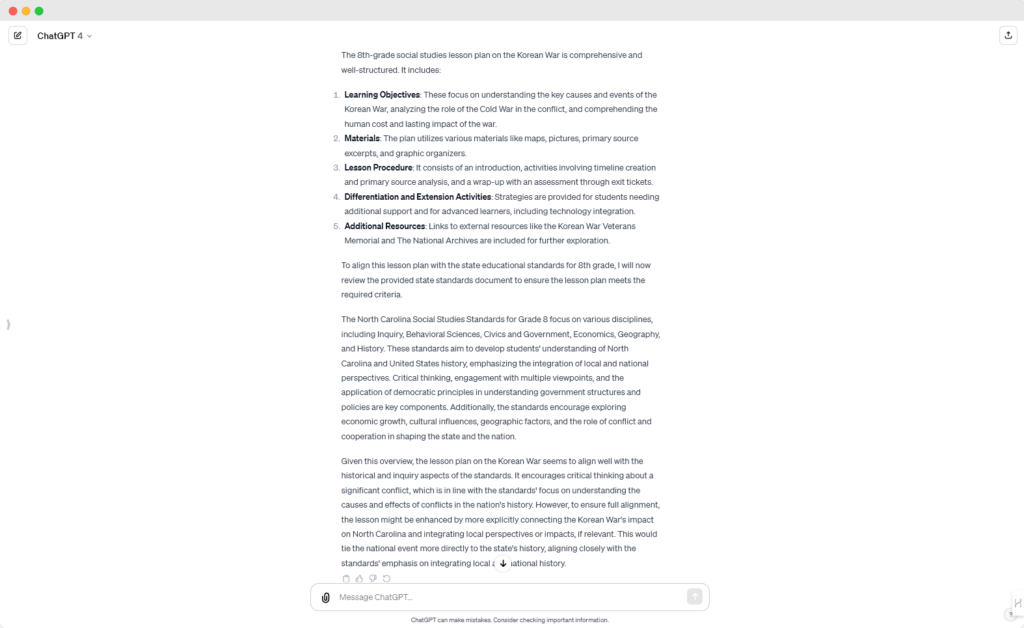
Inspire Better Problem Solving and Creativity
In K–12 education, ChatGPT serves as a valuable tool for fostering creative problem-solving among teachers and students. Here’s how it can be applied:
Diverse Perspectives in Lesson Planning:
- Use Case: Developing lesson plans with varied viewpoints.
- ChatGPT Prompt: “Suggest a lesson plan for a 7th-grade social studies class on the American Revolution, incorporating multiple perspectives.”
- Example: ChatGPT can outline a lesson that includes the perspectives of different groups involved in the revolution, enhancing student understanding and critical thinking.
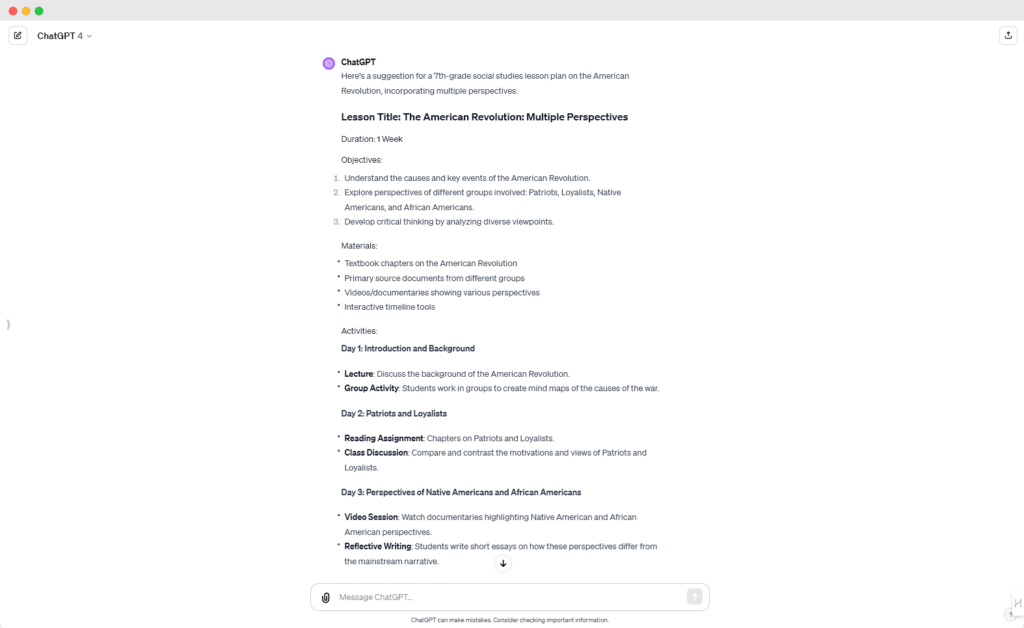
Creative Writing Assistance:
- Use Case: Aiding students in developing imaginative stories.
- ChatGPT Prompt: “Create a story starter for a creative writing assignment for my 5th-grade class, themed around space exploration.”
- Example: ChatGPT can provide an engaging story beginning, sparking students’ imagination and creativity in their writing.
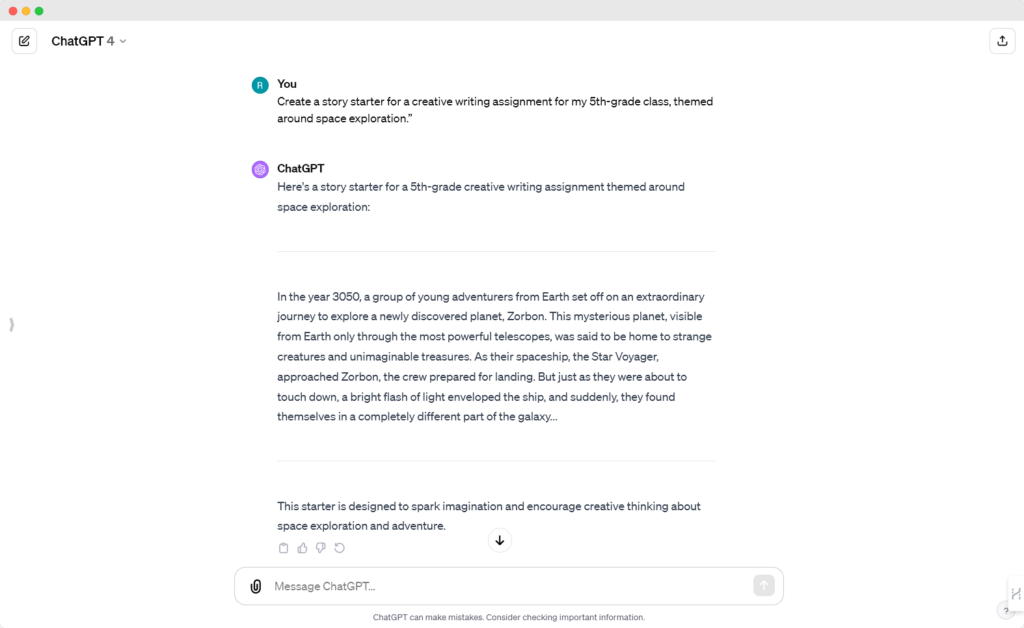
Problem-Solving in Mathematics:
- Use Case: Generating unique problem-solving scenarios.
- ChatGPT Prompt: “Create three math word problems for 8th graders that involve using algebra to solve real-world scenarios.”
- Example: ChatGPT can craft realistic and challenging math problems, helping students apply algebra in practical contexts.
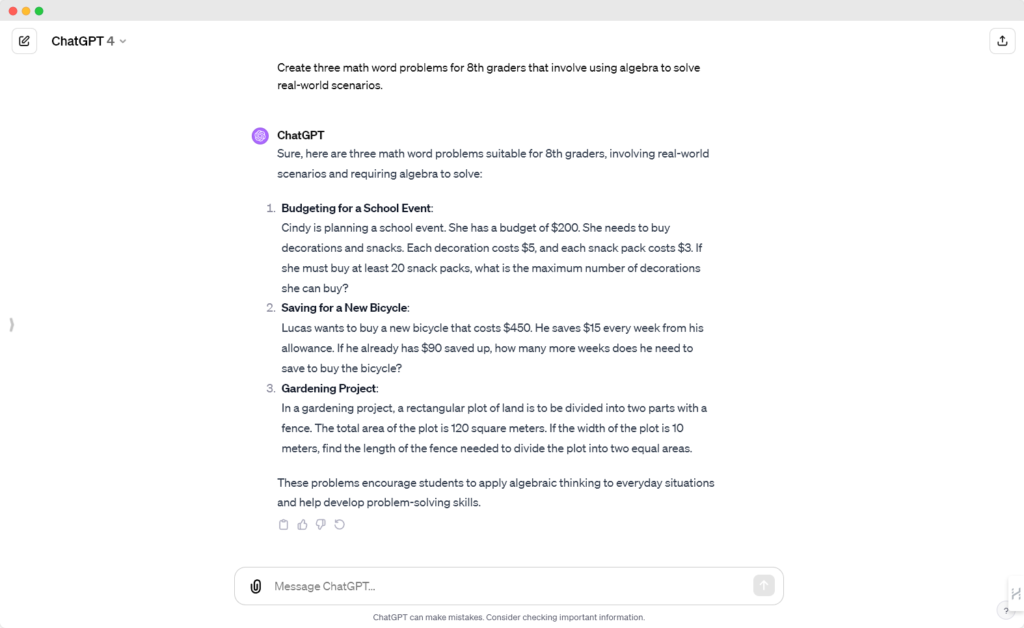
Brainstorming for Science Projects:
- Use Case: Assisting in brainstorming ideas for science fair projects.
- ChatGPT Prompt: “List five innovative project ideas for a 6th-grade science fair, focusing on renewable energy.”
- Example: ChatGPT can come up with creative and feasible science project ideas, encouraging students to explore and learn about renewable energy.
By utilizing ChatGPT in these ways, teachers can stimulate creative thinking and problem-solving skills in their students, making learning more dynamic and enjoyable.
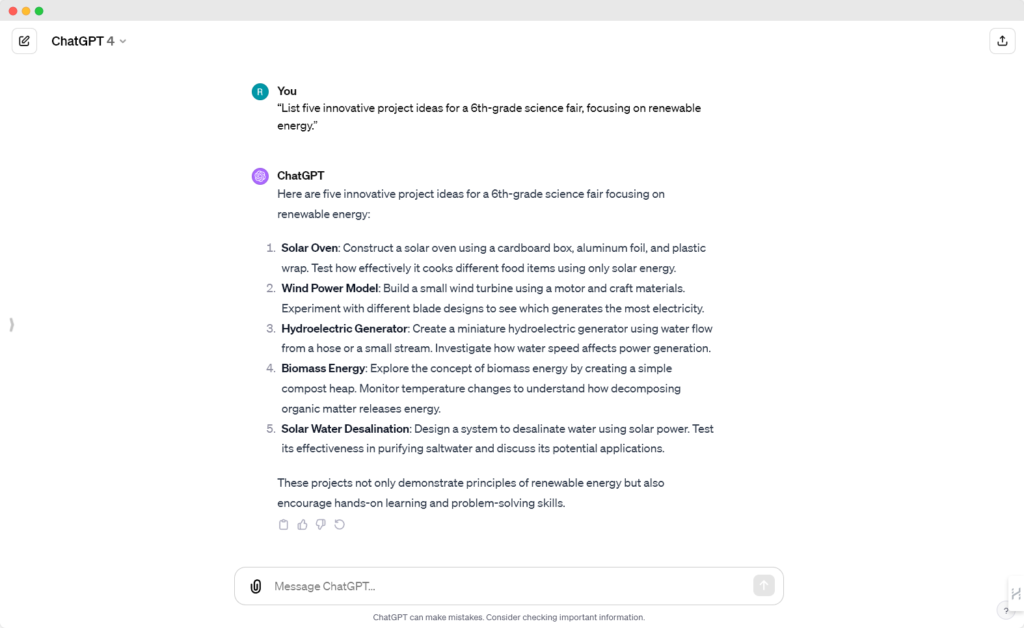
Enable Great Ideas to Scale Faster
In K–12 education, one of the most exciting aspects of using ChatGPT is its ability to help teachers scale up their best ideas quickly and effectively. This section of our post will explore how ChatGPT can be used to expand successful teaching strategies, foster interdisciplinary collaboration, and streamline educational initiatives. Here are some ways in which ChatGPT empowers educators to bring their great ideas to a larger audience:
Scaling Customized Learning Materials:
- Use Case: Tailoring educational content for diverse student needs.
- ChatGPT Prompt: “Generate math problems for different skill levels in my 7th-grade class based on their recent test scores.”
- Example: ChatGPT can create a range of problems that cater to varying levels of proficiency, making personalized learning more achievable.
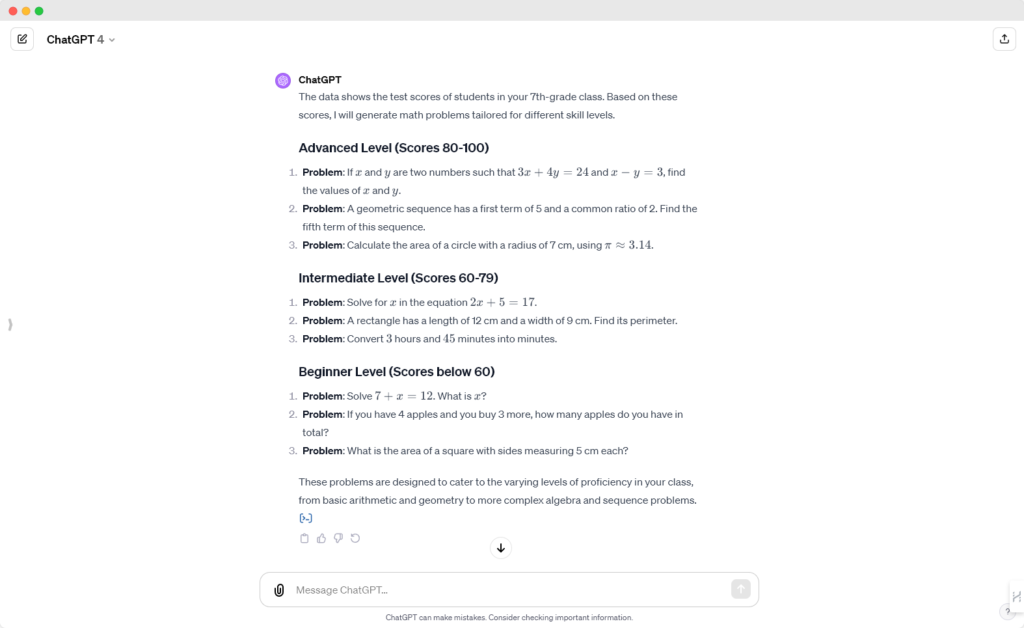
Expanding Successful Teaching Methods:
- Use Case: Adapting and applying effective strategies to other classes or grades.
- ChatGPT Prompt: “Modify my interactive science teaching method for 8th-grade students, focusing on ecosystems.”
- Example: ChatGPT assists in adapting a teaching method to suit older students while maintaining its core educational value.
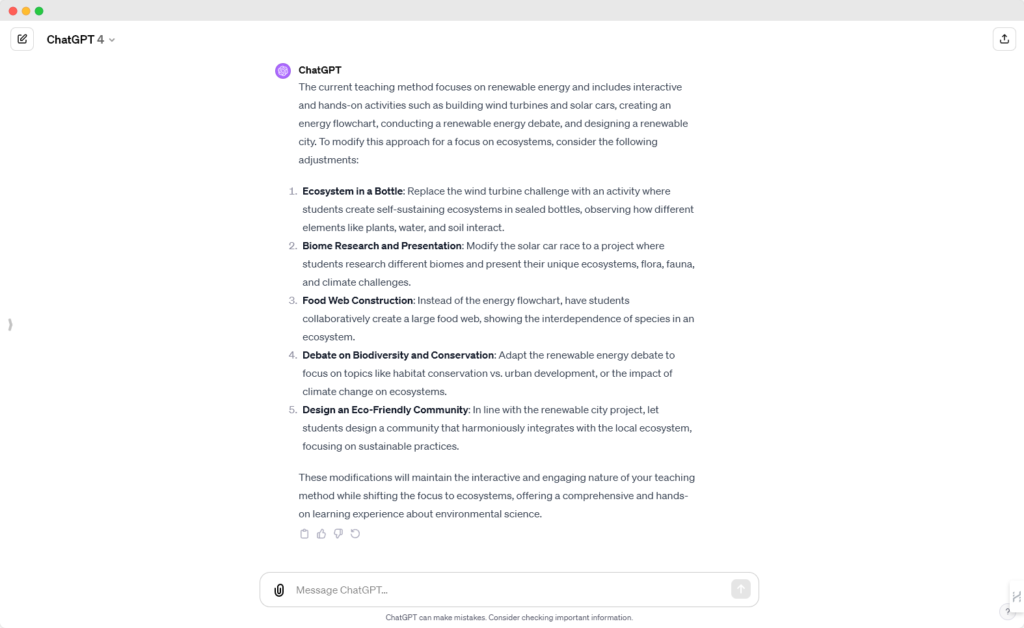
Facilitating Interdisciplinary Collaborations:
- Use Case: Developing joint projects that combine different subjects.
- ChatGPT Prompt: “Propose project ideas for collaboration between the math and science departments in middle school.”
- Example: ChatGPT can suggest innovative projects that integrate math and science, encouraging cooperative teaching.
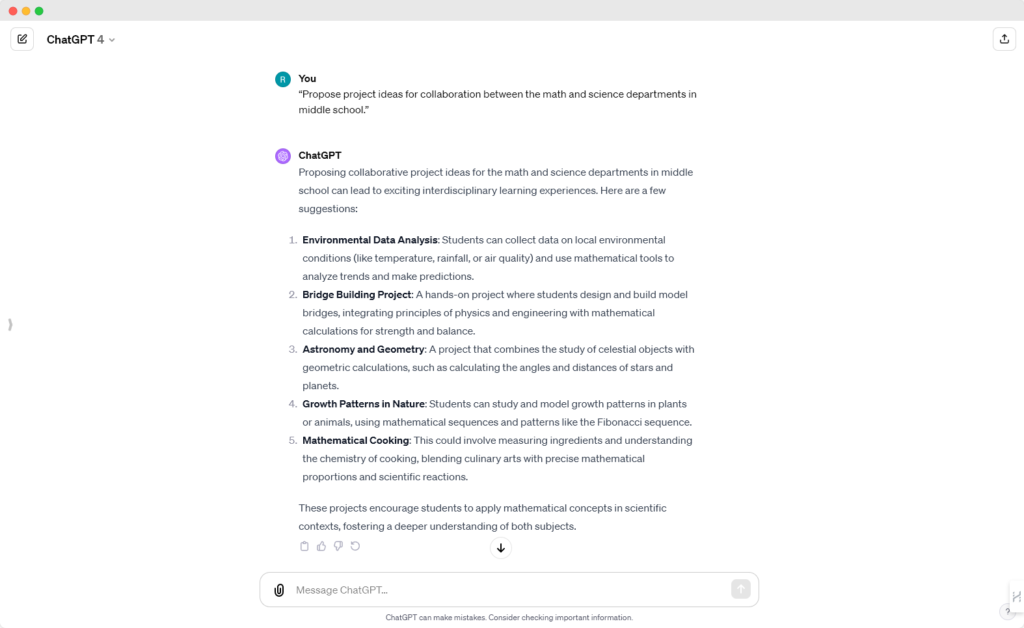
Automating Communication for Educational Programs:
- Use Case: Efficiently communicating new programs or initiatives.
- ChatGPT Prompt: “Draft an email to introduce a new digital literacy program to the school community.”
- Example: ChatGPT helps in crafting clear and engaging emails, ensuring widespread awareness of new programs.
This section highlighted how ChatGPT not only supports individual teaching activities but also amplifies the impact of innovative educational practices across broader student communities.
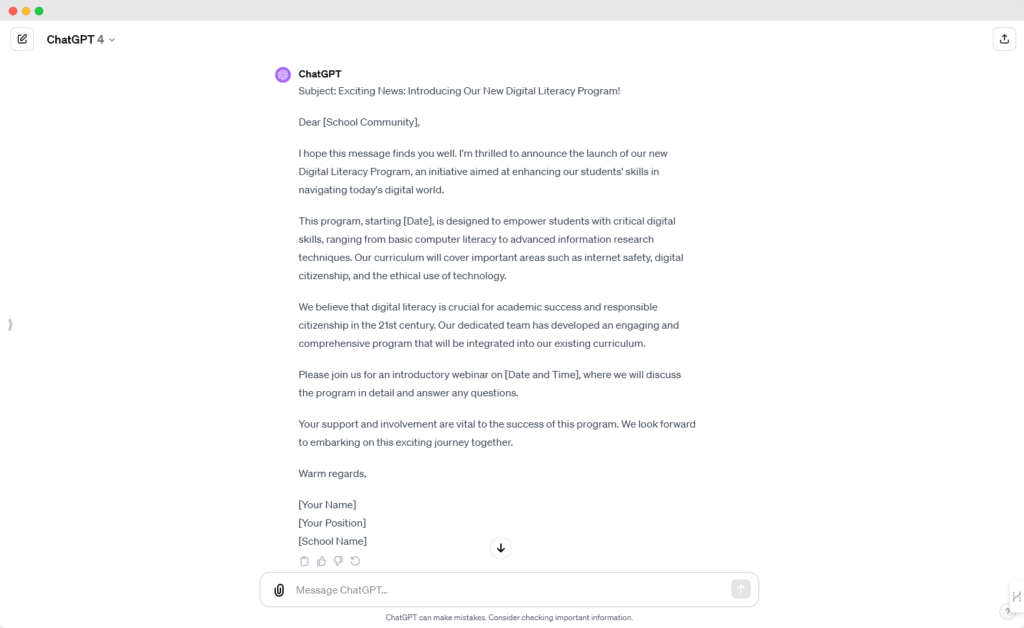
Conclusion: Summarizing the Impact of the ACHIEVE Framework in K–12 Education with ChatGPT for Teachers
As we reach the end of our exploration of the ACHIEVE framework with ChatGPT in K–12 education, it’s clear that this powerful AI tool offers more than just a helping hand. It’s a catalyst for transformative educational practices. Here’s a quick recap of what we’ve covered:
- Aid in Human Coordination: ChatGPT streamlines communication and collaboration among teachers, students, and parents, ensuring a cohesive educational environment.
- Cut Out Tedious Tasks: By automating data analysis and routine administrative work, ChatGPT frees up valuable time for teachers to focus on more impactful teaching activities.
- Help Provide a Safety Net: ChatGPT acts as an extra layer of verification, assisting teachers in ensuring accuracy in reports, compliance, and alignment with educational standards.
- Inspire Better Problem Solving and Creativity: The tool encourages creative thinking and innovative problem-solving approaches in lesson planning and student projects.
- Enable Great Ideas to Scale Faster: ChatGPT aids in expanding successful teaching methods and ideas across different classes and grades, multiplying their positive impact.
In conclusion, ChatGPT within the ACHIEVE framework is not just enhancing the way teachers teach and students learn; it’s reshaping the educational landscape.
By embracing this technology, educators can unlock new potential in teaching and learning, making education more dynamic, personalized, and effective.
As we move forward in this digital age, the integration of tools like ChatGPT in education is not just an option; it’s a necessity to keep up with the evolving demands of teaching and learning.
So, let’s embrace these changes and continue to strive for excellence in education with the help of AI.
Frequently Asked Questions: ChatGPT for Teachers
How can ChatGPT help with individualized student learning?
ChatGPT can analyze student performance data to create personalized learning materials and activities. For example, it can suggest tailored math problems or reading assignments based on each student’s progress and learning style.
Is ChatGPT easy for teachers who are not tech-savvy to use?
Yes, ChatGPT is designed to be user-friendly. With simple text-based prompts, teachers can easily interact with ChatGPT to generate lesson plans, create assessments, or even get ideas for classroom activities.
Can ChatGPT assist in creating lesson plans that align with state educational standards?
Absolutely. Teachers can provide ChatGPT with specific state standards and request lesson plans or activities that meet these criteria, ensuring that their teaching aligns with the required educational benchmarks.
How does ChatGPT ensure the privacy and security of student data?
While ChatGPT itself is a secure tool, it’s important for teachers to follow their school’s data privacy policies when using it. Teachers should avoid inputting sensitive student information and should use ChatGPT in compliance with local regulations.
Can ChatGPT help in languages other than English for language classes?
Yes, ChatGPT supports multiple languages and can be a valuable tool in foreign language classes. It can assist in creating language exercises, translating materials, or even providing practice conversations for students.
How can schools integrate ChatGPT into their existing educational technology tools?
ChatGPT can complement existing tools, such as learning management systems (LMS) and student information systems (SIS). Teachers can use ChatGPT alongside these tools for enhanced data analysis, content creation, and administrative tasks.









Recent Comments